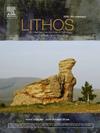Petrogenetic processes in alkaline magmatism in the southern Mozambique Channel
IF 2.9
2区 地球科学
Q2 GEOCHEMISTRY & GEOPHYSICS
引用次数: 0
Abstract
Whereas the northern part of the Mozambique Channel, between the eastern coast of Africa and Madagascar, is intensively studied, the southern part remains poorly investigated. The 2014 PAMELA-MOZ01 and 2015 PAMELA-MOZ04 cruises enabled us to collect volcanic rocks from the submarine flanks of the Bassas da India-Europa complex, including Bassas da India atoll, Europa Island, and Jaguar and Hall Banks. Despite significant alteration, probably due to their prolonged stay in seawater and the hydrothermal circulation they underwent, we are able to describe the main petrological and geochemical aspects of these largely unknown lavas. To achieve this, we integrated petrographic and mineralogical observations with geochemical analyses of the dredged rocks, aiming to identify the key aspects of the alteration and to characterize their petrological and geochemical properties.
The volcanism of this region is characterized by strongly silica-undersaturated alkaline magmas. Here, we demonstrate that this volcanism is marked by a bimodal magmatic activity with ultrabasic and basic compositions, and more silica-rich compositions. Using isotopic signatures and trace elements, we suggest that magmas are produced by a low degree of partial melting (1 to 5 %) of a metasomatized mantle at about 80 km depth. These mafic magmas then rise from the source to the surface via several magma storage levels, located at about 25–30 km and 15 km depth, the latter corresponding to the mantle-crust boundary as identified by geophysical methods. Fragments of zoned sanidine phenocrysts within intermediate lavas (olivine-free nephelinite or tephri-phonolite) also suggest the presence of differentiated magma reservoirs. Our observations strongly support frequent magmatic recharges, coupled with magma differentiation through olivine + clinopyroxene crystallization/assimilation, in long-lived magma reservoirs. In many respects, this volcanism has similar characteristics (nature of the source, degree of partial melting, composition of the lavas, age, and spatial distribution) to those of the Miocene to Quaternary volcanic provinces of Madagascar, the northern Mozambique Channel or the East African Rift. We propose that this volcanism might result from regional extension through the Mozambique Channel and the southern part of the East African Rift System, coupled with a thermal erosion of a mantle plume.
莫桑比克海峡南部碱性岩浆作用的成岩过程
莫桑比克海峡的北部,位于非洲东海岸和马达加斯加之间,已经得到了深入的研究,而南部的调查却很少。2014年PAMELA-MOZ01和2015年PAMELA-MOZ04巡航使我们能够从Bassas da India-Europa复杂的海底侧翼收集火山岩,包括Bassas da India环礁,欧罗巴岛,美洲虎和霍尔银行。尽管有明显的变化,可能是由于它们在海水中长期停留和热液循环,我们能够描述这些很大程度上未知的熔岩的主要岩石学和地球化学方面。为了实现这一目标,我们将岩石学和矿物学观察与地球化学分析相结合,旨在识别蚀变的关键方面,并表征其岩石学和地球化学性质。本区火山活动以强硅质欠饱和碱性岩浆为特征。在此,我们证明了该火山活动的特征是双峰岩浆活动,具有超基性和碱性成分,并且含有更多的富硅成分。利用同位素特征和微量元素,我们认为岩浆是由交代地幔在约80公里深度的低程度部分熔融(1 - 5%)产生的。这些基性岩浆然后通过几个岩浆储存层从源头上升到地表,分别位于25-30公里和15公里的深度,后者对应于地球物理方法确定的地幔-地壳边界。在中间熔岩(不含橄榄石的钠云母岩或软云母岩)中发现的分带带的白晶石斑晶碎片也表明存在分化的岩浆储层。我们的观测结果强烈支持在长寿命岩浆储层中频繁的岩浆补给,以及通过橄榄石+斜辉石结晶/同化的岩浆分异。在许多方面,这种火山活动与马达加斯加中新世至第四纪火山省、莫桑比克海峡北部或东非裂谷的火山活动具有相似的特征(来源的性质、部分融化的程度、熔岩的组成、年龄和空间分布)。我们提出,这种火山活动可能是由于通过莫桑比克海峡和东非裂谷系统南部的区域延伸,加上地幔柱的热侵蚀。
本文章由计算机程序翻译,如有差异,请以英文原文为准。
求助全文
约1分钟内获得全文
求助全文
来源期刊

Lithos
地学-地球化学与地球物理
CiteScore
6.80
自引率
11.40%
发文量
286
审稿时长
3.5 months
期刊介绍:
Lithos publishes original research papers on the petrology, geochemistry and petrogenesis of igneous and metamorphic rocks. Papers on mineralogy/mineral physics related to petrology and petrogenetic problems are also welcomed.
 求助内容:
求助内容: 应助结果提醒方式:
应助结果提醒方式:


